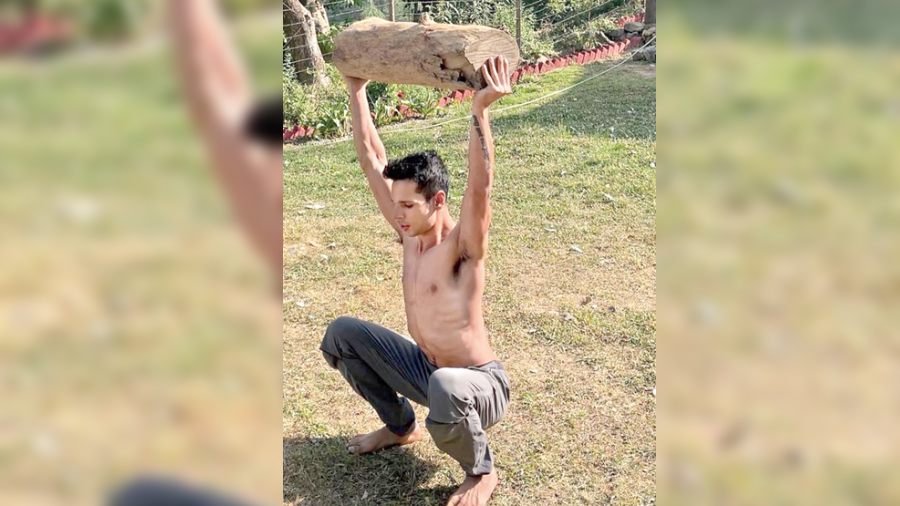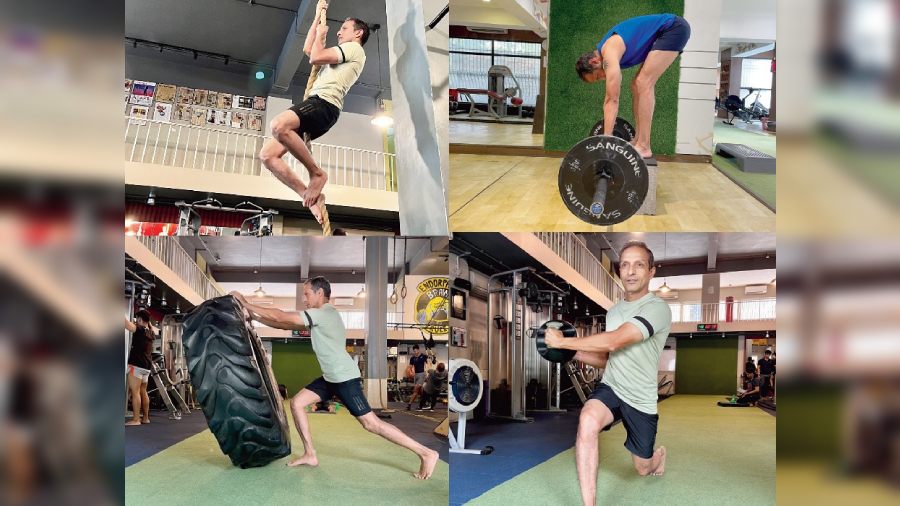It may surprise a lot of people but students of evolutionary movement history are aware that exercise patterns were fairly constructed far back in human history. Clubs, lances, kettlebells and, of course, free weights and gymnastic equipment have been in use for centuries. There is pictorial evidence that hanging and swinging ropes were used as far back as Tsarist Russia as props for physical enhancement. Our Indian pahalwans have been using clubs or mugdars since early 18th century for strength development.
So what exactly is the basis of exercise? How is it that most exercise patterns have not changed in hundreds of years? What lies at the root and origin of these patterns?
According to Paul Chek, a US-based master of holistic and corrective exercise and kinesiology, “Exercise movement systems were born out of seven key movements that I feel were necessary for survival in our developmental environment.”
Chek makes a connection between human evolution and exercise. It is also my strong belief and conviction that man developed exercise patterns based on real-life demands and requirements. Gradually, the human musculoskeletal architecture owed its resilience to these movement patterns and repetition of these patterns over time helped man to build a strong and stable muscular and metabolic health system.
Paul Chek calls these seven basic movements “primal pattern movements” and goes on to suggest that if you were not able to perform these movements correctly and effectively, you probably would not survive in the wild.
Consider this: If early man was not able to climb a tree or escape quickly from external danger like a forest-fire or predatory attack, his survival in the wild would have been extremely difficult. Our lifestyle in the industrialised world may have moved far away from our ancestors, but anatomically, our original designs remain unaltered. Which means that the same movement patterns are still key to performing daily tasks and remaining injury-free. If we study the movement mechanics of some of the ancient exercise forms like yoga, early calisthenics and martial arts, we can clearly observe how these forms embody the seven movement patterns as described by Chek.
Chennai-based strength and conditioning coach Shankar Basu who was the fitness trainer for the Indian cricket team from 2014 to 2019 and proprietor of Primal Patterns Gym in Chennai, feels that if athletes are unable to perform all the required primal pattern movements in their sport, their performance would be reduced and the likelihood of injury would increase. Effectively, all movements in sports can be broken down to seven primal movements. Our daily movement demands are also similar in many ways to the movement needs of sport. We walk, we bend to pick up things, we lift grocery bags, we climb steps, we may have to change car tyres. All these are very much a part of the seven movement patterns.
Any deficits in performing these movements effortlessly will slowly increase the physical load on our musculoskeletal system, leading to chronic pain and injury. As therapeutic exercise coaches, we endeavour to identify and rectify these deficits in order to prevent dysfunction, pain and disability in future.
Squat
This requires little explanation. We are squatting all the time to do various things. Even if you live a sedentary life, you have to squat to get into your car seat, or squat to sit on a chair and get up from it. A lot of our village population use the basic squatting pattern for defecating. This is popularly called the “Indian style” and is now being recommended by health and wellness practitioners all over the world for its manifold benefits to the metabolic and musculoskeletal system. Medical practitioners feel that defecating in this position is the best way to empty the colon and also great for reproductive health in women. In fact, in many cultures all over the world, childbirth is encouraged in a squatted position.
Lunge
Ask any mountaineer or even a recreational trekker or climber and he/she will tell you that traversing uneven and rough terrain would be impossible without the ability to execute a good lunge pattern. The lunge works on the stability and strength of your ankles, knees, legs and core. In sport, while throwing a ball, an athlete’s inability to lunge properly often results in shoulder injuries. In the non-athlete, failure to lunge correctly significantly increases the chances of falls.
Bend
Try to build a mental picture of early man and his activities throughout the day — building shelter, picking berries and fruits, lifting tree planks and plucking vegetables among other tasks and chores. The bend pattern would have to be a dominant movement theme. After the hunter/gatherer period, man discovered agriculture, which would have also required him to spend long hours in bent position. Fast forward to the modern world where a motor mechanic as well as an orthopaedic surgeon may have to spend a disproportionate amount of time in forward bent position. In the industrialised world, bend patterns are used daily by construction workers. A nurse or parent lifting a baby from the cot represents a bend and pick up movement. Bending, like the other primal movements, is an integral part of our daily activity. If you can’t do it properly, your chances of injury escalate. The dead lift is commonly taught in the gym as it simulates the bend pattern. The waiter’s bow test is used by therapists to assess the proper functional ability of the spine and hip to work in sync with each other.
Push
Early man was capable of generating very strong pushing forces. Moving heavy objects to build shelter or clear land would be impossible without this ability. During fights, pushing strength will dictate your ability to clear your opponent off the fighting arena. A farm worker’s ability to herd sheep, cows, horses, pigs and other animals into pens and shoots depends in no small measure on his pushing strength. Anyone who has suffered a car breakdown and has had to push his car to the mechanic’s might have discovered the need and benefits of pushing ability.
Pull
“Once downed, a game animal isn’t going to follow you home!” writes Chek in his path-breaking book, How To Eat, Move And Be Healthy! You had to pull and drag the heavy carcass back. The pulling pattern is as ubiquitous in sports and daily activities as the bend pattern. The Olympic rower is a master of the pull.
Twist
Twisting is the most dynamic of all patterns since it plays a key role in many of the primal movements. For example, twisting is an essential part of throwing. Orthopaedic surgeons will tell you that the most common source of back injuries today is a movement that combines twisting and bending. Many golfers injure their backs because the golf swing requires them to twist the torso in a bent position. Since twisting movements of the spine are integral to almost every movement performed in a functional environment, it’s safe to say that if you can’t twist correctly, you must learn to do so, because injury is lurking.
Gait
This is perhaps the most commonly used primal pattern in our daily lives. All except those who are bedridden or in a wheelchair walk every day, while a small segment of the population jogs and a smaller still sprint. Rewind to a time when hunting prey would need us to sprint fast, while gathering would mandate that we wander and walk for hours. Escape from predators was impossible unless we learnt to get away fast. Tilling land, gathering berries, grazing sheep and cattle, communicating messages — there are many reasons early man had to develop swift and effective locomotive skills. The health and wellness of our metabolic and musculoskeletal system depends a lot, even today, on gait patterns.
Ranadeep Moitra is a strength and conditioning specialist and corrective exercise coach

Aman Poddar, movement coach at Endorphins, demonstrates a squat pattern
The primal pattern exercises
These exercises are absolutely essential to master and practice. If you do only a couple of these from each pattern and nothing else, you will stay fit:
Squat: Free squats, Swiss-ball squats, weighted front and back squats, yogic sitting patterns
Lunge: Alternate leg free lunges, static lunges, surya namaskar, multi-directional lunges, lunges holding a barbell, or dumb-bells
Bend: Dead lift, one-legged dead lift, Virabhadrasana
Push: Bench press, parallel-bar dips, push-ups, Indian push-ups, cable chest press
Pull: Barbell rows, inverted rows, seated rows, one-arm cable pulls
Twist: Swiss-ball Russian twists, straight-leg wipers, Swiss-ball supine wipers
Gait: Step-ups, walking lunges, running, walking, sprinting
